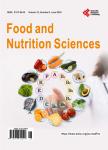Modeling Dietary Fiber Intakes in US Adults: Implications for Public Policy
Modeling Dietary Fiber Intakes in US Adults: Implications for Public Policy作者机构:不详
出 版 物:《Food and Nutrition Sciences》 (食品与营养科学(英文))
年 卷 期:2011年第2卷第9期
页 面:925-931页
学科分类:1002[医学-临床医学] 100214[医学-肿瘤学] 10[医学]
主 题:Dietary Fiber Adults Statistical Modeling of Fiber NHANES
摘 要:Objective: The goal of this study was to simulate the application of the dietary recommendations to increase dietary fiber (DF)-containing foods. Methods: This study used 24-hour dietary recalls from NHANES 2003-2006 to model the impact of different approaches of increasing DF with current dietary patterns of US adults 19 + years: 1) increased all DF-containing foods by 10, 25, 50, or 100%;2) increased DF content of low DF grain products to a good (2.5 g/serving) or an excellent source level (5.0 g/serving);and 3) increased intake of whole grain foods to meet the recommendation of one-half of total grain. Results: Increasing DF-containing foods by 10, 25, 50, or 100% increased DF intake to 16.9, 18.9, 22.1, and 29.5 g/d, respectively with a concomitant increase in energy of 104, 260, 521, 1042 kcal/d, respectively. Adding 2.5 or 5.0 g/serving DF to low DF grain foods to result in DF intakes of 24.7 and 39.1 g/day, respectively without increased energy. Increasing consumption of whole grain foods increased DF intake to 25.3 g/day but with an additional 1266 kcal/d. Conclusions: Adding additional DF to existing grain-based foods may be a reasonable approach to getting more DF, without increased energy, in the American diet.



